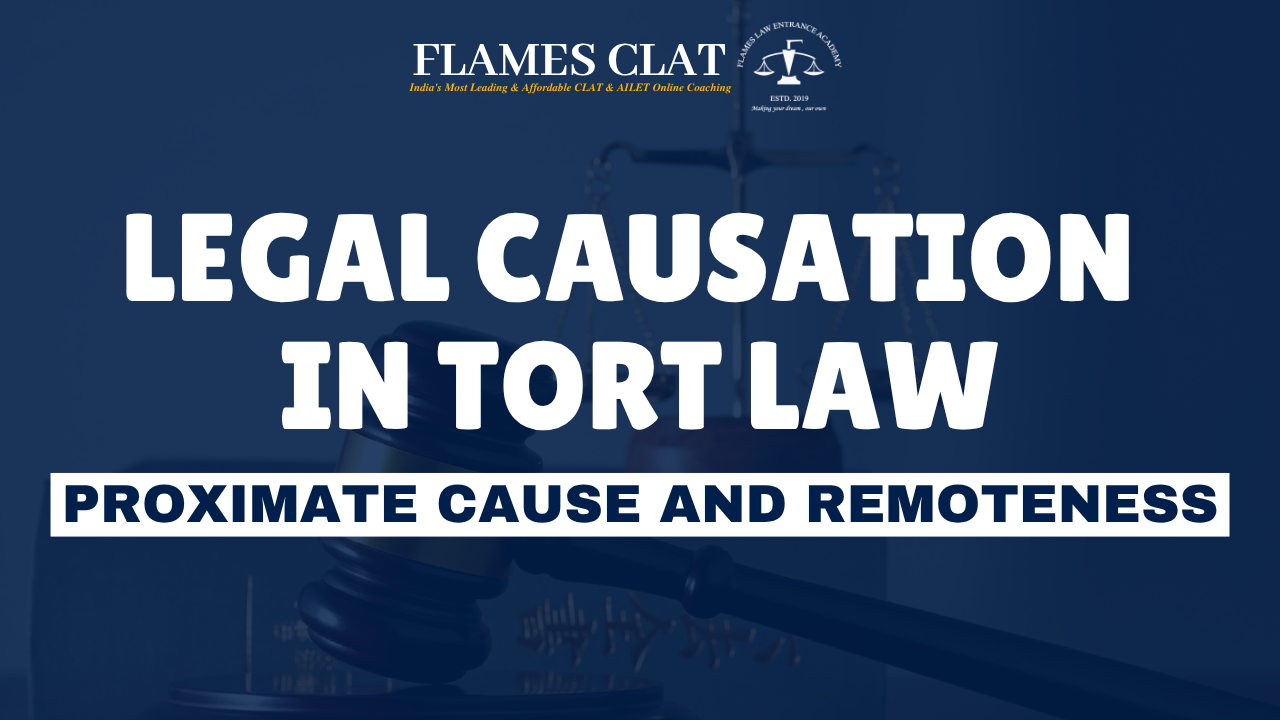Legal Causation in Tort Law: Proximate Cause and Remoteness
Tort is committed when the defendant's actions cause damage to the plaintiff. The liability of the defendant, however, depends on the cause of damage and whether that damage was predictable. At Flames CLAT Academy, where future legal professionals are trained to think critically and interpret evolving laws, such concepts are frequently discussed in classes and workshops to nurture legal minds. This blog aims to explore the causation under Tort Law, proximate causes, and the remoteness of damage.
Causation
Causation means the action that leads to some consequence. In Tort law, this consequence is the damage suffered by the plaintiff. However, to hold the defendant liable, the plaintiff needs to prove that the damage was caused by the defendant’s actions, being both actual and legal cause. This rule helps in determining the liability of a person’s consequences under Tort Law. Alongside, it also protects them from the limitless liability of unforeseen circumstances.
Causation can be classified into:
a. Factual Causation
Cause-in-fact examines if the defendant's actions directly caused the damage. It is often called a necessary condition test, as the defendant’s action is essential to cause the harm. It is the first step in determining the liability of a two-factor cause. Tests used for determining factual causation are:
- “But for” test – it asks whether the defendant's action caused harm or it would have occurred but for the defendant’s act.
- Substantial factor test – it determines liability by considering if the defendant’s action was a factor in causing the damage.
b. Legal Causation
Also known as the Proximate cause, determines liability by establishing a link between the actions and the consequences by asking if the consequence was expected from the action. This introduces us to the concept of remoteness, discussed further in detail, which absolves defendants' liability when the damage is unforeseeable.
Proximate Cause
Proximate cause, in simple terms, is the actions whose consequence is foreseeable to the defendant. It holds a person liable only when the damage is such that any reasonable person would have foreseen at the time of the reckless action. For instance, a person driving at an excessively high speed on a busy road can foresee a collision if the car is not controlled in time. Tests used to determine the proximate cause are:
- Foreseeability Test – It stipulates that the damage must be an anticipated consequence of the defendant’s action. It was established in Palsgraf v. Long Island Railroad Co. (1926).
- Directness Test – On the contrary, this rule holds the defendant liable for all direct consequences following the actions of the defendant. This rule was established in Re Polemis & Furness, Why & Co Ltd. (1921).
- Zone of Danger Concept - It elucidates that only those who are at actual risk by the defendant's action can impose liability on him.
Remoteness of Damage
Remoteness of damage means the distance between the action and the consequence to establish the defendant’s liability. The court assesses this remoteness by determining if the damage was predictable by a reasonable person. Tests used to determine remoteness are:
- Reasonable Foreseeability Test – Established in the Wagon Mound Case (1961), it elucidates that the defendant is liable when the damage is foreseeable, and not liable if damage is remote to the actions.
- Eggshell Skull Rule – It holds the defendant liable for all consequences originating from his actions, even if it is unforeseeable as illustrated in the Smith v. Leech Brain & Co. Ltd. (1962) case.
Relevant Case Laws
- Barnett v. Chelsea & Kensington Hospital (1969)
This case demonstrates how the test ‘but for’ and substantial factor tests work. In this case defendant was not held liable for a lag in hospital treatment, as the death could have occurred even if the patient had been treated at the hospital.
- The Wagon Mound Case (1961)
It rejected the test of directness and held the appellants not liable for damage caused to the respondent’s equipment by the fire ignited due to the spilling of oil because of the appellants' negligence.
- Scott v. Shepherd (1773)
The Squib Case, wherein a person threw a lighted squib into a crowd, which fell on multiple people and resulted in the loss of an eye of the plaintiff. The defendant’s action however, was considered a proximate cause of the plaintiff’s injury.
Conclusion
The theories of proximate cause and remoteness of damage both examine the actions of the defendant on different metrics but share a common aim. They ensure that people are not held liable for consequences that are not foreseeable during the commission. Legal educators at Flames CLAT Academy continue to emphasize such concepts as essential for aspirants preparing for CLAT and judiciary exams, where understanding the concepts of Tort law is not just an academic goal but a tool for application in real-world scenarios.
Join our Flames CLAT Family at https://t.me/flamesclat
For Informative videos, do check out https://youtube.com/@flamesclat?si=-PqiaRLEjutM-iYj




Write a Review
Your email address will not be published. Required fields are marked *